-
Paper Information
- Paper Submission
-
Journal Information
- About This Journal
- Editorial Board
- Current Issue
- Archive
- Author Guidelines
- Contact Us
Journal of Nuclear and Particle Physics
p-ISSN: 2167-6895 e-ISSN: 2167-6909
2023; 13(1): 7-16
doi:10.5923/j.jnpp.20231301.02
Received: Aug. 6, 2023; Accepted: Aug. 21, 2023; Published: Aug. 23, 2023

Simulation of the Optimal Scheme for Stimulating Actinide Photofission on the M-30 Microtron at 17.5 Mev Bremsstrahlung Energy
Eugene Oleinikov, Igor Pylypchynets, Oleg Parlag
Institute of Electron Physics, Universitetska 21, Uzhgorod, Ukraine
Correspondence to: Eugene Oleinikov, Institute of Electron Physics, Universitetska 21, Uzhgorod, Ukraine.
| Email: |  |
Copyright © 2023 The Author(s). Published by Scientific & Academic Publishing.
This work is licensed under the Creative Commons Attribution International License (CC BY).
http://creativecommons.org/licenses/by/4.0/

Bremsstrahlung beams obtained at electron accelerators stimulate the photofission reaction of actinides. Their parameters significantly depend on the design features of accelerators and sample activation schemes. As a result of the simulations carried out by the GEANT4 Monte-Carlo code, the optimal parameters of the actinide sample activation scheme at the M-30 microtron were calculated. The scheme provides experimental conditions for generating the bremsstrahlung beam with the maximum photon content and the minimum content of residual electrons and secondary photoneutrons that interact with the studied actinide samples. The parameters of the developed stimulation scheme for the M-30 microtron can be applied to different accelerator types, taking into account their design features, characteristics of the studied samples, and implemented activation schemes.
Keywords: Actinide photofission, Electron accelerator – microtron, GEANT4 toolkit
Cite this paper: Eugene Oleinikov, Igor Pylypchynets, Oleg Parlag, Simulation of the Optimal Scheme for Stimulating Actinide Photofission on the M-30 Microtron at 17.5 Mev Bremsstrahlung Energy, Journal of Nuclear and Particle Physics, Vol. 13 No. 1, 2023, pp. 7-16. doi: 10.5923/j.jnpp.20231301.02.
Article Outline
1. Introduction
- The study results of the mechanism of actinides photofission reactions and their characteristics provide essential information about the properties of atomic nuclei since the nature of the photon-induced interactions is well known and allows obtaining fissionable nuclei directly after their absorption [1,2]. In addition, the information on the yields of actinides photofission products (fragments, prompt, and delayed neutrons) is relevant for solving a wide range of applied problems. These tasks are related to the development of new-generation energy-generating systems ‒ reactors with accelerators (controlled subcritical systems [3]), non-destructive methods of isotopic analysis of fertile nuclear materials [4,5], and alternative methods of developing medical radioisotopes [5]. The above-mentioned directions require reliable data on the yields of actinide photodissociation products.Bremsstrahlung radiation obtained at electron accelerators is widely used to stimulate the actinides photofission reaction [2,4-6]. The bremsstrahlung photons and their energy spectra, obtained by converting electron beams into bremsstrahlung radiation (the generation process of which occurs due to radiative braking of electrons), depending on the initial energy of the electrons and the nuclear-physical properties of the materials from which the converters (converters of electron radiation into photons) are made [7-9]. Also, the bremsstrahlung photons and their energy spectra are affected by the geometric size of the initial electron beams (geometric shape of the cross-section in the beam plane, their distribution in space) and converters [10,11].Since the optimal thickness of the converters (when the output of bremsstrahlung photons is maximum) is less than the electron’s mean free path in the substance from which the converter is made [12], there will be residual electrons in the beams of bremsstrahlung radiation [13,14].Residual electrons, when interacting with the studied actinide samples, can generate secondary photons [15] and photoneutrons [16,17] in them, as well as additionally stimulate electronuclear and photonuclear reactions [18] and cause damage to the samples due to their heating (thermalization). In addition, secondary photoneutrons will be present in the bremsstrahlung beam formed in the converter material through e → γ → n reaction channels [19]. These factors can significantly affect the results of studies of the actinides’ photofission characteristics.Thus, when the activation schemes of samples on electronic accelerators do not use magnets to remove electrons that have passed through the Ta-converter [20,21], there is a need to "clean" bremsstrahlung beams from residual electrons and secondary photoneutrons.For "cleaning" bremsstrahlung beam without significantly weakening the intensity of photons, filters are used, which are made of materials with a small atomic number such as reactor graphite, aluminum, and boron carbide [13,22,23].It should be noted that the quantitative (integral) number of photons, residual electrons, and secondary photoneutrons and their ratio in the bremsstrahlung beams that interact with the studied actinide samples are significantly influenced by geometric factors (the location of the converters and the studied samples relative to the electron output node of the accelerator), and the presence of additional structural elements (filters, screens, collimators), which are used in their formation [24]. Also, the final parameters of the bremsstrahlung beams will be influenced by the design features of the devices (assemblies) ‒ their output node, which differ significantly for different types of electron accelerators [25]. Therefore, these factors must be taken into account when developing actinide sample activation schemes.To optimize the schemes (conditions) of irradiation of actinide samples by electron accelerators, it is necessary to have complete and reliable information about the characteristics of the bremsstrahlung beam and its components (photons, residual electrons, photoneutrons) that determine the radiation field of the beam and associated particles. Comprehensive information about the radiation fields is contained in the energy distributions of the bremsstrahlung components if they are known for any angle of photon emission from the target for the three-dimensional distribution relative to the axis of the electron beam.Conducting experimental studies of the characteristics of the bremsstrahlung spectra, residual electrons, secondary photoneutrons, and their integral values (for example, with activation and tracking detectors, TLD dosimeters, and proportional counters [26,27]) is associated with significant difficulties (expensive and long-term measurements) and in many cases practically impossible.To obtain information about the characteristics of bremsstrahlung beams obtained at electronic accelerators that interact with the studied samples, taking into account their design features and irradiation schemes, computer modeling using Monte Carlo software codes (MCNP6, FLUKA, GEANT4 [28,29]) is widely used, as they make it possible to obtain the spectra of bremsstrahlung photons, residual electrons, and secondary photoneutrons as closely as possible to the real conditions of their formation.The presented work aims to model the optimal scheme for stimulation of the actinides’ photofission reaction on the electron accelerator of the Institute of Electronic Physics of the National Academy of Sciences (IEP NAS) of Ukraine - microtron M-30, taking into account the technical characteristics of its output node.
2. Materials and Methods
- A software application was developed for modeling the photon spectra, residual electrons, and secondary photoneutrons, which were formed during the interaction of electrons with the Ta-converter and hit the plane (area in the location of the investigated actinide samples) or the samples themselves, installed perpendicular to the beam axis of the primary electron beam. The application was implemented in C++ using the GEANT4 10.7.1 toolkit [30,31]. The choice of the specified toolkit was determined by its suitability for modeling the formation processes of various types of particles and their interaction with the studied samples on electronic accelerators [2,9,28], as well as its availability in terms of free use.The developed application gave a possibility to implement various variants of actinide activation schemes by taking into account the installation of structural elements (converters, filters, samples) in the three-dimensional space given by the input data. The simulation results of the activation process according to the given schemes made it possible to visualize the images of the profiles of all photons and electrons that hit the plane at the location of the studied actinide sample.This made it possible to reproduce real irradiation schemes of the investigated actinide samples for implementation on electronic accelerators (in this case, on the electronic accelerator of the IEP of NAS of Ukraine - the M-30 microtron [26]).The application was created for the Windows platform using multi-threading mode. A computer with a 6-core Intel (R) Core (TM) i7-9750H (2.60 GHz) processor and 36 GB of RAM was used for calculations. With the specified material base, calculations were made for the number of 1E8 events ÷ 1E9. The average calculation time was ~ 8-10 hours.Calculations were made for 17.5 MeV electron energy. The output electron beam had the shape of an ellipse with axes of 22 × 6 mm and an equally probable distribution (taking into account the design features of the electron output node - a titanium window with a thickness of 0.05 mm) [32,33].Figure 1 shows the scheme of stimulation of actinide photofission reaction by the M-30 microtron, where 1. is the output node of the M-30 microtron; 2. Ti-window; 3. Ta-converter; 4. filter (diameter – 35 mm, thickness – 19 mm); 5. a sample of actinide. Additionally, the photo of the output node is presented. The distance from the output node to the tantalum (Ta) converter was 22 mm.
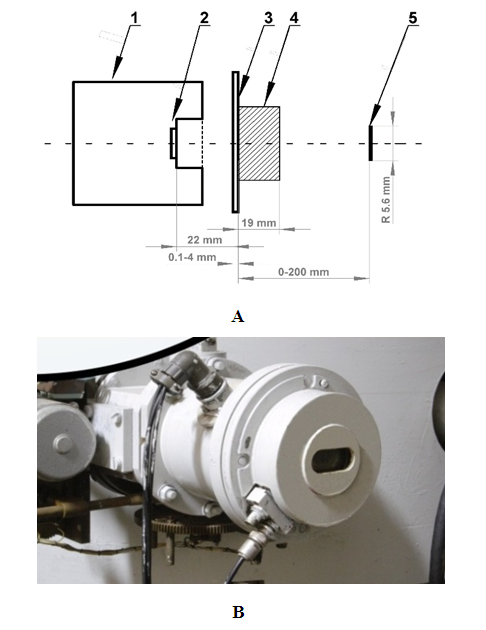 | Figure 1. Scheme of stimulation of the photodissociation reaction of actinides on the M-30 microtron (A) and photo of its output node (B) |
3. Results and Discussion
- Simulations were carried out on the effect of the Ta-converter thickness (from 0.1 to 4 mm) on the characteristics of the bremsstrahlung spectra at a fixed distance from the converter to the place of sample installation of 75 mm. As a sensitive detector, a plane with the size of 1000x1000 mm and a cylinder corresponding to the dimensions of the real test sample were taken.The spectra of bremsstrahlung photons and residual electrons interacting with the plane were obtained in the result of modeling and are shown in Figures 2 and 3. Similarly, the spectra of photons and electrons interacting with the real target are shown in Figures 4 and 5.
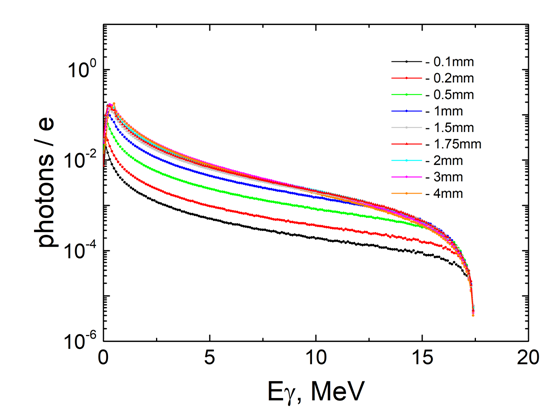 | Figure 2. Bremsstrahlung spectra for different thicknesses of the Ta-converter that hit the plane |
 | Figure 3. Spectra of the residual electrons for different thicknesses of the Ta-converter that hit the plane |
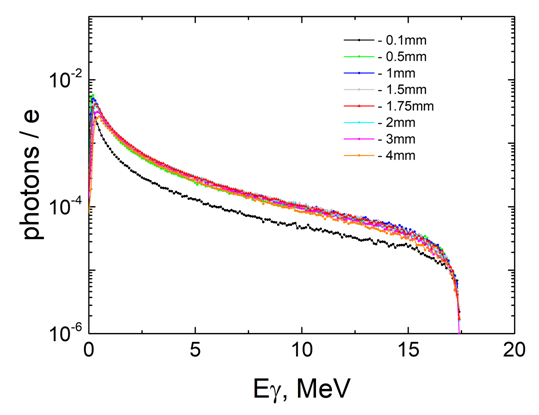 | Figure 4. Bremsstrahlung spectra for different thicknesses of the Ta-converter that hit the real actinide sample |
 | Figure 5. Spectra of the residual electrons for different thicknesses of the Ta-converter that hit the real actinide sample |
 | Figure 6. Dependence of the integral values of bremsstrahlung photons on the thickness of the Ta-converter that hit the plane and the studied sample |
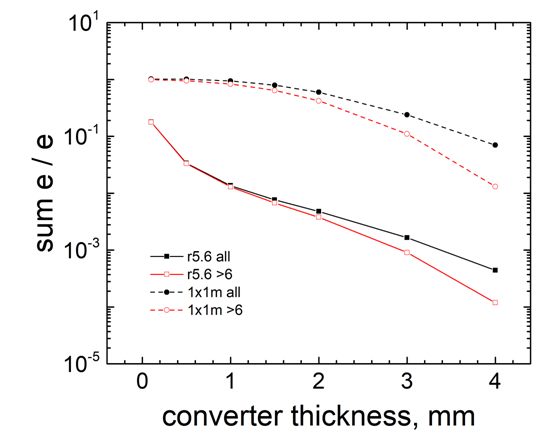 | Figure 7. Dependence of the integral values of the residual electrons on the thickness of the Ta-converter that hit the plane and the studied sample |
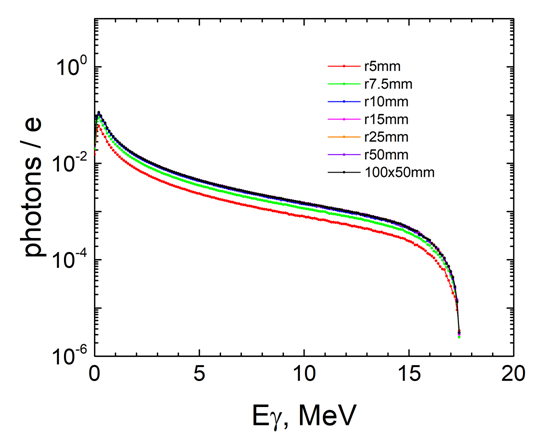 | Figure 8. Bremsstrahlung spectra for different radii of the Ta-converter that hit the plane |
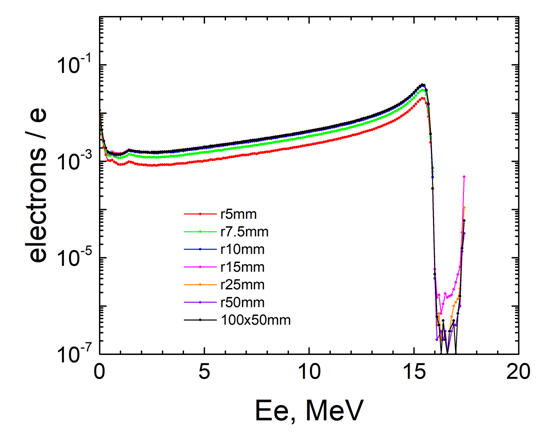 | Figure 9. Spectra of the residual electrons for different radii of the Ta-converter that hit the plane |
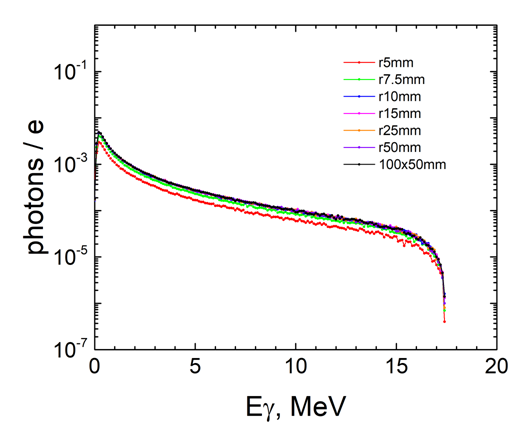 | Figure 10. Bremsstrahlung spectra for different radii of the Ta-converter that hit the real actinide sample |
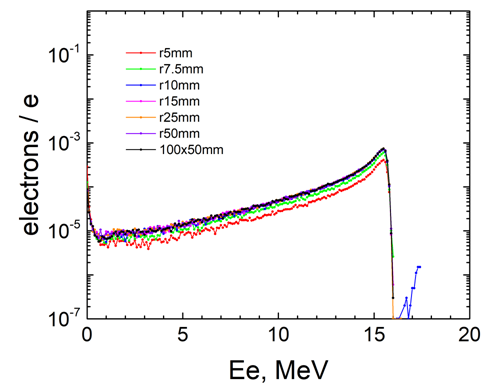 | Figure 11. Spectra of the residual electrons for different radii of the Ta-converter that hit the real actinide sample |
 | Figure 12. Dependence of the integral values of bremsstrahlung photon spectra on the radius of the Ta-converter (thickness 1 mm) that hit the plane and the real actinide sample |
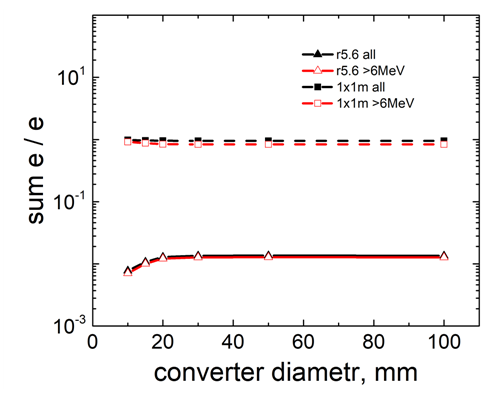 | Figure 13. Dependence of the integral values of residual electron spectra on the radius of the Ta-converter (thickness 1 mm) that hit the plane and the real actinide sample |
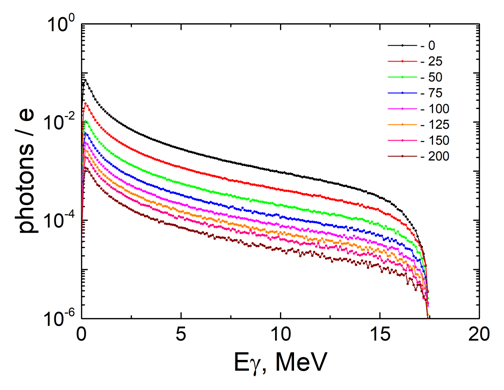 | Figure 14. Bremsstrahlung spectra for different distances of Ta-converter – sample |
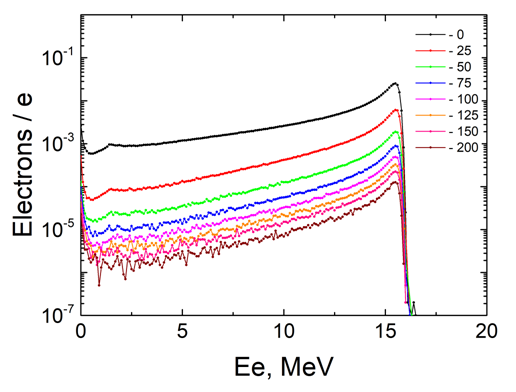 | Figure 15. Spectra of residual electrons for different distances of Ta-converter – sample |
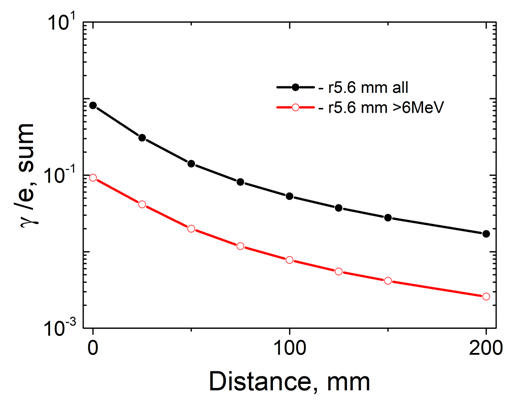 | Figure 16. Dependences of the integral values of bremsstrahlung photon spectra on the distance Ta-converter – sample |
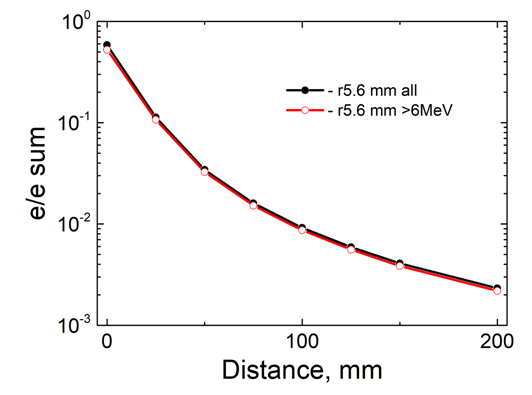 | Figure 17. Dependences of integral values of residual electron spectra on the distance Ta-converter – sample |
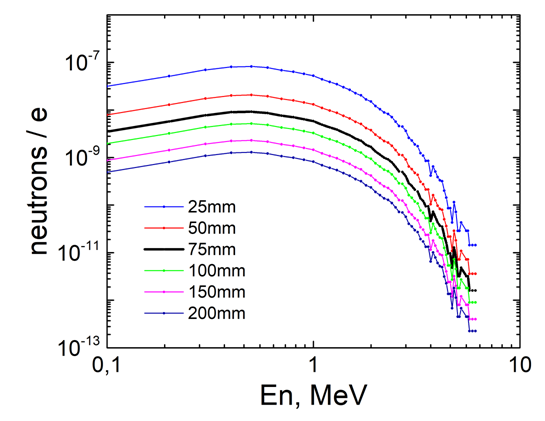 | Figure 18. Photoneutron spectra for different distances of Ta-converter – sample |
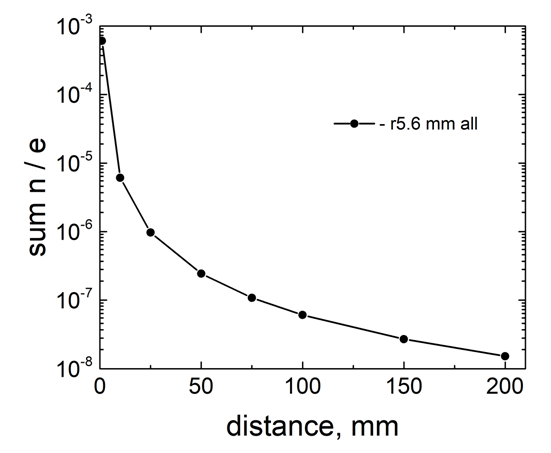 | Figure 19. Dependencies of the integral value of photoneutrons on the distance Ta-converter – sample |
 | Figure 20. Bremsstrahlung spectra interacting with the sample without and with the B4C filter |
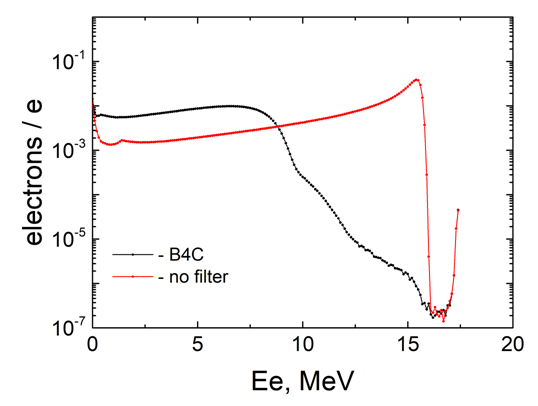 | Figure 21. Spectra of residual electrons interacting with the sample without and with the B4C filter |
 | Figure 22. Spectra of photoneutrons interacting with the sample without and with the B4C filter |
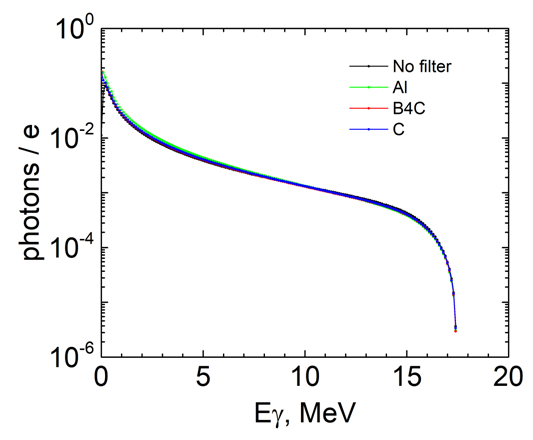 | Figure 23. Bremsstrahlung spectra interacting with the sample without and with various filters |
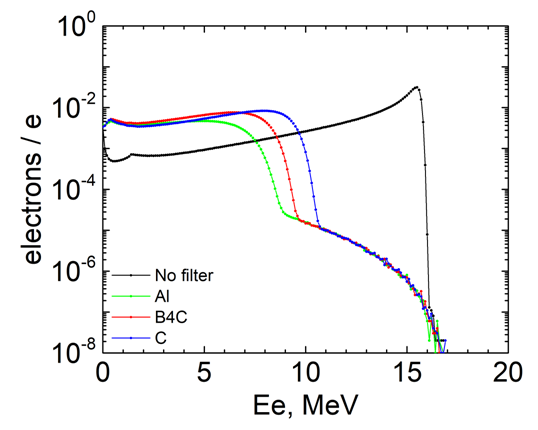 | Figure 24. Spectra of residual electrons interacting with the sample without and with various filters |
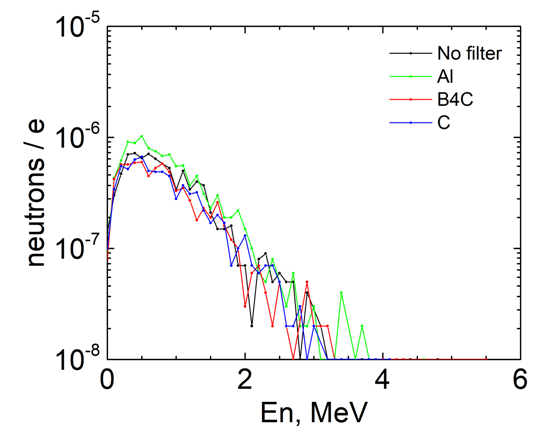 | Figure 25. Spectra of photoneutrons interacting with the sample without and with various filters |
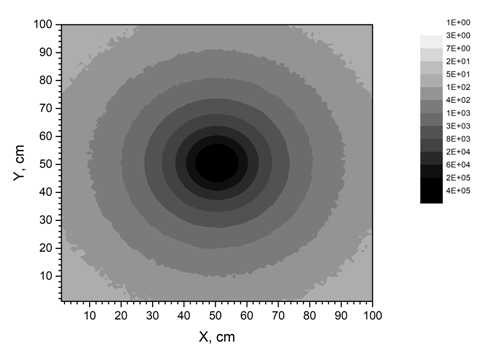 | Figure 26. Profile of a beam of residual electrons that hit the plane |
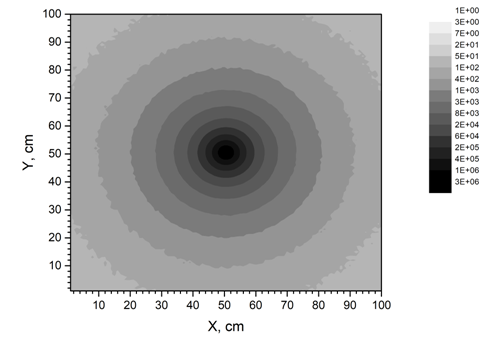 | Figure 27. Profile of a beam of photons that hit the plane |
4. Conclusions
- Conducted theoretical calculations using the GEANT 4 toolkit made it possible to establish the optimal parameters of the stimulation scheme for the photofission reactions of actinide samples on the M-30 microtron electron accelerator using a combined Ta + B4C target. The obtained information is necessary for the formation of bremsstrahlung beams with the maximum number of photons and the minimum number of residual electrons and secondary photoneutrons, which interact with the studied actinide samples, and that takes into account the geometric sizes of the elements of the activation scheme (converters, filters) and their location, as well as the design features of the electron output node of the M-30 microtron.This approach can be used for the development of actinide activation schemes in the study of their nuclear-physical characteristics, as well as for a wide range of applied applications: photonuclear activation analysis of the isotopic composition of fertile and fissile nuclear materials, transmutation of spent nuclear fuel, alternative production of medical radioisotopes on various types of electronic accelerators.
Funding
- The present work was partially carried out within the framework of the project of research works of young scientists of the National Academy of Sciences of Ukraine. State registration number – 0123U102958).
 Abstract
Abstract Reference
Reference Full-Text PDF
Full-Text PDF Full-text HTML
Full-text HTML